“Don’t be That VR Guy,” I keep thinking. I’ve spent the last couple of weeks playing Elite: Dangerous, a PC space-sim that works with the newest Oculus Rift virtual reality headset. It’s been pretty amazing, and I’m having a hard time not being That VR Guy.
You know That VR Guy, right? Lately, it seems everyone in the gaming press is taking turns being That VR Guy, the guy who says that this virtual reality game or that virtual reality game blew his mind and made him want to leave this plane of existence altogether.
He’s the guy who plays an Oculus Rift game and then writes these sorts of things:
“For a few minutes in a busy convention center in Los Angeles, I was one with my ship. I was Rogue Leader, I was Starbuck, I was the Last Starfighter. I loved it. Elite Dangerous is the reason I play video games.” – Greg Tito, The Escapist
“It’s insane, and ambitious to the point of insanity; but what’s incredible is how the game is actually living up to these promises. We recently took the beta release for a spin on the Oculus Rift DK2, and staggered away, several hours later, still gawping from the experience.” – Tom Rudderham, The Rift Arcade
“All the technical mumble jumbo in the world can’t encapsulate the utter amazingness of this device. The squeal-demanding, face-melting, mind-bending, soul-rending miraculousness of the experience. It’s just…. oh my god you guys. I really did not want to ever take it off.” – Eric Limer, Gizmodo
“Elite: Dangerous on Oculus Rift DK2 with a custom classic rock playlist is so fucking cool I kinda can’t even. I mean it’s my job, at least in part, to accurately describe why cool video games are cool, and I’m practically at a loss on this one.” – Some guy on Twitter
I’ve logged around 26 hours in the beta of Elite: Dangerous, and almost all of those hours have been spent wearing a big black headset on my face.
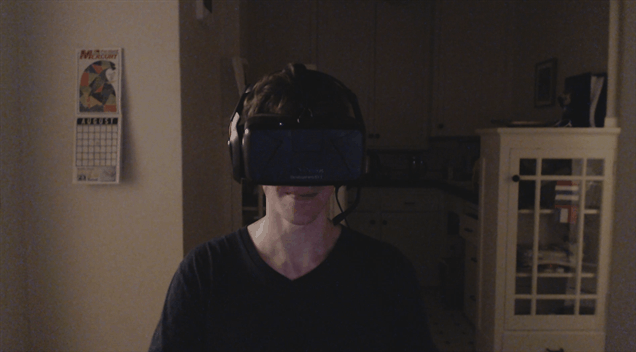
Each session leaves me a bit wild-eyed, with big dumb red visor marks around my eyes.
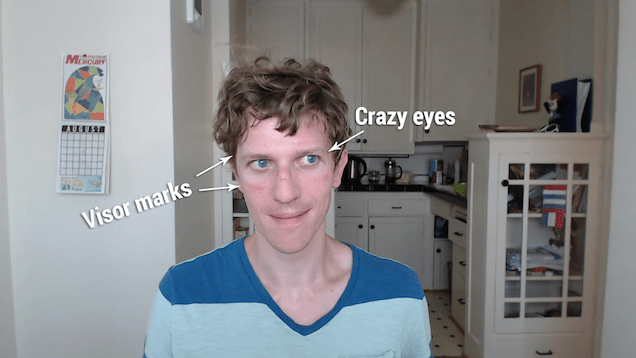
It’s worth a little discomfort. The experience of playing Elite: Dangerous with an Oculus Rift is often flat-out astonishing, and for all the individual problems, rough edges, niggles, and bugs, it presents a convincing case for the future of gaming and VR.
I’ve got a lot to say about Elite: Dangerous as a game, Elite: Dangerous as a VR experience, and about the Oculus Rift and VR in general. Today, I thought I’d start by focusing on those first two.
What the heck is Elite: Dangerous?
Elite: Dangerous is the fourth game in the storied Elite series of PC outer-space sims, wherein you sit in the pilot’s chair of a space-cruiser and explore the universe, undertaking all sorts of different tasks both lawful and unlawful. It hails from the underrated “two adjective” school of video-game naming, and I’m glad they didn’t decide to call it Awesome: Radical or Immersive: Compelling.
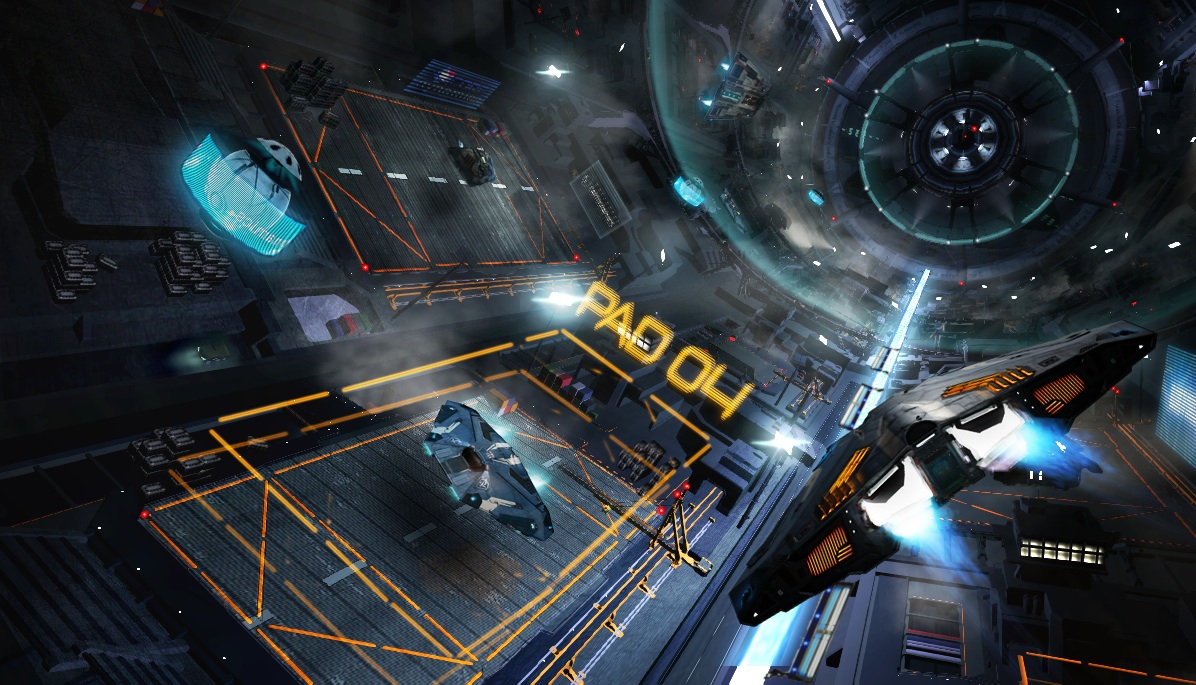
Dangerous is the first Elite game since 1995’s Frontier: First Encounters. Creator David Braben has been trying to get a fourth Elite game made for years now, and the process is finally underway thanks to a successful $US2 million Kickstarter drive.
(As it happens, Elite: Dangerous isn’t the only crowdfunded classic PC space-sim in development. Wing Commander creator Chris Roberts has so far bagged more than $US50 million for his game Star Citizen, which is earlier on in development than Elite: Dangerous but looks similarly appealing. Prediction: Many of the comments below this article will be about which game is better. My advice to those commenters: Lay down your arms and celebrate our unexpected space-sim bounty together, as brothers and sisters!)
The version of Elite: Dangerous that you can play right now is in beta, and if you want in, you’ll have to pay. Beta access costs $US75, which will get you a copy of the finished game, a pre-order of which costs $US50 without the beta. The current beta offers a slimmed-down but still substantial chunk of space to explore, and the developers are planning a second beta at some point later this year.
It’s unlikely that any progress you make in the current beta will carry over to the main game. That said, the people at Frontier told me that if you pay for the beta now, you won’t have to deal with any substantial downtime between now and then. You’ll have something to play all the way through to the release of the final game, which they say will happen later this year.

The planned final version sounds wildly ambitious. 150,000 star systems to explore, all taken from actual astronomical data, with the entire Milky Way galaxy — 400 billion star systems total — procedurally generated from scientific models. An MMO-like framework that allows you to play on a server loaded with other players, with an economy that reacts to the ebb and flow of trade. Space-combat straight out of Star Wars, space-trading right out of EVE Online. Eventually (hopefully?), according to Braben, the ability to get out of your ship and explore space stations, sneak aboard enemy vessels, pilot a ship cooperatively with your friends, and even explore alien worlds. And the whole thing will work both on your PC monitor and through a VR headset.
“We have some really exciting future plans that will continue to deliver amazing VR experiences,” Braben told me in an email. “Imagine the spectacle, spatial awareness and feeling of vulnerability of bouncing along the surface of a moon in a buggy as you race against others to be first to some stashed black market goods.” OK, yes, I can and will imagine that.
Even in the somewhat limited beta, Elite: Dangerous is the kind of game that many of us thought we might never see again. If you grew up on PC space-combat games like Wing Commander, the X-Wing and TIE Fighter series, or the original Elite games, Elite: Dangerous will feel immediately familiar. As my ship pulls up from a hyperdrive jump and a 3D hologram pops up on my targeting display, I feel a familiar buzz. Who knew that a space flight-sim could make me so nostalgic?
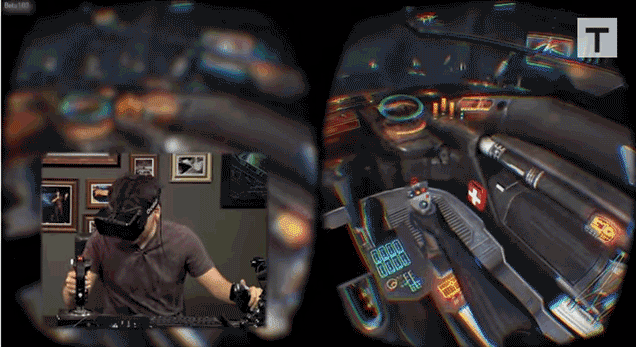
DK2 = Not Donkey Kong 2
The VR headset I’ve been using is the Oculus Rift DevKit 2, known as the DK2 by hip cool people who are in the know. It’s the second prototype headset from Oculus, intended more for game developers than for the gaming public, though a fair number of hardcore PC gamers have gone ahead and bought one. There is a commercial version of the Rift coming sometime in the next couple years, but this isn’t it.
This article isn’t a deep-dive into the DK2 and its capabilities. For that, you can check out the video below, in which Tested.com‘s Will Smith and Norman Chan (the latter of whom is in the gif above) put the DK2 through its paces on a number of games and demos, including Elite: Dangerous.
As far as Oculus-specific stuff goes, I also liked game critic Richard Cobbett’s write-up at his blog, in which he tries out a bunch of various Rift games and demos and provides both enthusiastic endorsement and healthy scepticism. Cobbett appears similarly concerned with not being That VR Guy.
I’ll have more thoughts on the Oculus Rift and on virtual reality in general later. For now, let’s talk about Elite: Dangerous.
It doesn’t quite feel like “playing a video game.”
Despite all of the grand plans Braben and his team have for their game, for the beta, you mostly sit in the cockpit of your ship. You fly from starport to starport, hauling cargo, going on combat sorties in contested zones, hunting for salvage out in the deeps of space, and engaging in old-fashioned piracy.
If you want, you can play the game on your PC monitor like an ordinary person, and if you do that, you’ll almost surely have a good time. But of the many hours I’ve put into the beta, almost all of them have been while wearing the Rift DK2.
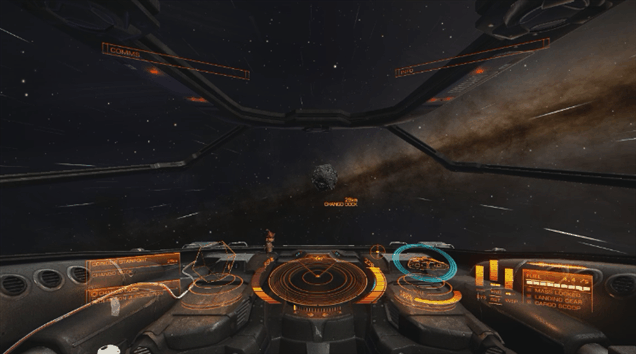
Here’s how the VR version of Elite: Dangerous works: Your character is sitting in the captain’s chair, left hand on the throttle, right hand on a flight stick. (If you’re like me, you got a HOTAS flight stick and throttle, so your real-life posture matches that of your in-game character.) If you look down, you’ll see your body in the chair below you. Your in-game avatar has really good posture. It makes you self-conscious.
You can look all around the cockpit freely; look to your left and a holographic navigation panel pops up. Look to your right, and you can page through your ship’s systems information. Look up, and you can see the vastness of space, expanding above you. Look behind you, and you’ll see the back wall of the cockpit, though sometimes the headrest on your captain’s seat will get in the way. Thanks to the positional head-tracking on the Rift DK2, you can lean your head around the inside of the cockpit — text can be awfully grainy from a distance, but now you can lean closer to make it more readable.
There’s not much I can write to convey the feeling of thereness that the headset imparts. It’s not easily explained or even demonstrated, but in the moment, it feels so natural that I quickly stop thinking about it at all. I’m sitting in the cockpit of my ship. Of course I am. This thing is here, that thing is there, that other thing is over there.
This kind of game — a “cockpit game” — is an ideal opening argument for the potential of virtual reality. That’s mainly because for all the space-hopping and barrel-rolls you might do in the game, your actual in-game “body” remains still. Your body and the cockpit it occupies are a fixed reference point that your brain can use to make sense of what it’s seeing, which helps stave off some of the less pleasant side-effects of VR, like nausea and disorientation. After an hour or two of play, it’s a surprising comfort to look down and see my unmoving digital body right there, while my actual body is occupying the same space. It’s reassuring, to the point where I actually find myself feeling discombobulated when I play on my PC monitor and can no longer see my in-game body.
I’ve begun to think of it like this: Playing Elite: Dangerous on the Oculus Rift doesn’t quite feel like playing a video game. It feels more like actually doing something, like I’m undertaking the activity the game is simulating. I sit there in my cockpit, looking around and taking stock, flying into spaceports to take on more cargo, flipping switches and setting waypoints and charting hyperdrive jumps. When I take off the headset, it’s as though I’ve just spent the last few hours somewhere else.
I am the most boring starship captain.
For some reason, I find myself gravitating toward the most mundane tasks available. I like hauling cargo, flying from space station to space station. I like the routine of it all, of pulling into the spaceport entryway, getting clearance to land, spotting my parking spot, pulling off a perfect parking job.
(It’s remarkable how much the current version of Elite: Dangerous revolves around parking. They could’ve called it Space Parking Simulator 2014.)
As I turn my head to survey the inside of my long-haul space cruiser, it doesn’t matter that I’m not shooting at anyone. For now, this is plenty exciting enough. I’m not a space pirate, or a bounty hunter; I’m a regular mope, a guy who drives shipments of chemicals and vegetables from one system to another. It’s pretty great.
If I wanted, I could head to a contested war zone to do some old-fashioned Star Wars-style dogfighting. There is an instanced battle near to the starting starport that comes remarkably close to making this cinematic trailer a reality:
I’ve found, however, that those parts of the beta feel the most familiar to me, and are the least interesting. The Oculus Rift is really cool in a dogfight, mind — there’s nothing quite like the first time an enemy ship zooms past your cockpit and your head follows him up and above you, you punch your booster and drop your vertical thrusters, desperate to get him in your sights.
All the same, I currently prefer the long, slow rhythms of hauling and trading. Elite isn’t actually known just as a space-combat series; it’s a space trading series, with a built-in commodities market. Savvy players can long-haul shipments from system to system and cut a tidy profit as fast if not faster than a pirate or bounty hunter can earn cash via force.
For my first several hours in the beta, I would take small deliveries from system to system, a short-haul trucker saving up to buy a better rig that would let me make longer hauls. Finally, I began to study the commodities market, learning that I could fill up on HEV Suits in the Asellus Primus system, jump to the LP 98-132 system and sell them for a profit. These days I have a few solid routes worked out (I’m getting rich hauling advanced catalysers from Asellus Primus to Dahan), a healthy reserve of credits for buying cargo, and I’m starting to make money hand over fist.
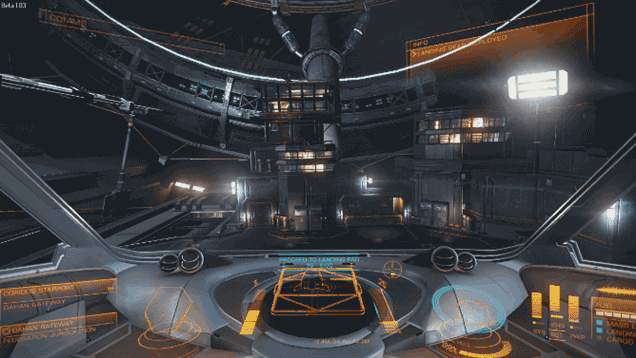
Trading is the easiest way to make money in the beta. My current plan is to build up a couple hundred thousand credits trading, then use my savings to buy whatever souped-up combat vessel looks most fun, should I decide I want to go do some dogfighting. (In the beta, you can only have one ship at a time, though the final game should offer some way to own and maintain several vessels at once.)
I’ve got the whole thing down to a routine at this point. Pick up shipment, fly to a new system. Set cruise control and carefully manage my approach so I don’t overshoot. Land, sell off my cargo, pick up new cargo. Rinse and repeat.
It’s soothing, in its way. I like to turn on an Rdio playlist of classic rock tunes, and if you’re already playing the game, let me highly recommend going that route. There’s nothing quite like dropping out of a hyperdrive jump with some Creedence on the radio, pulling your long-distance hauler into a parking spot, doing some quick trading, filling up the tank, and going on your way. Classic rock improves the experience of Elite: Dangerous almost as much as the Oculus Rift does.
It ain’t perfect…
Granted, a lot of my time playing Elite: Dangerous with the Rift has been fuelled by the sheer novelty of it all. It’s far from a fluid experience, and there are a number of things that need addressing:
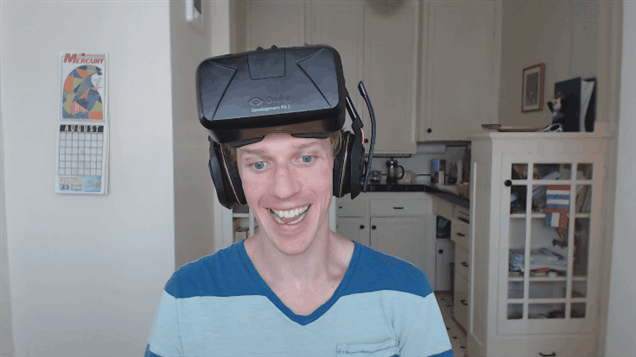
- The software is a headache to get working. If you want to play Elite: Dangerous in VR, you’ve got to navigate some serious obstacles. You’ll have to set the Rift up a certain way, set up the desktop and resolution a certain way, force-quit a couple of background applications, adjust the game’s settings just so, and hope that you did everything in the right order. It feels finicky even for PC gaming. (Braben tells me that they’re already looking at the new Rift software development kit and will continue developing through the beta and beyond to get everything working as well with the Rift as possible.)
- Your head comes off your in-game body. When you engage your ship’s superdrive, your vision pushes backward as your ship accelerates. It’s a cool visual, but it can leave your in-game “head” floating a foot or so too far back from your “body,” which is gross and weird and discombobulating.
- Text is too low-res. Most of the text in my ship’s pop-ups is too difficult to read. Thanks to the DK2’s positional tracking, I can lean in and read text, but it’d be nice to simply be able to glance over at my readouts and see what they say.
- It’s unwieldy as hell. Setting up the Rift in the game means setting up my HOTAS, putting the headset on my forehead, finding my headphones, dropping the rift into place, putting the headphones on, then getting all set and ready to go. Cables are everywhere, and godspeed, should you decide you need to clean your Rift’s lenses. There is no easy way to do any of it, no quick way to extricate yourself from it should someone knock on the door or walk into the room. It is very hard to be cool while wearing an Oculus Rift.
- Things get crusty at long distances. Up close, everything in the game looks beautiful. But get too far away from a space station or another ship, and it begins to look like a jumble of jaggy lines and ugly colour splotches. Considering how sharp Elite: Dangerous looks on my computer monitor, it’s hard not to wish it looked that sharp on the Rift.
- There are a lot of bugs. Sure, I’m pretty psyched about the overall experience of Elite: Dangerous with the Oculus Rift, but there are a lot of weird visual bugs, areas where the frame-rate drops to a weird jittery shuffle, flashes of white light, non-responsive menus, crashes, and more. It’s a beta; these things are to be expected.
- The game itself is unproven. Again, this is typical of a beta, but there are a lot of unanswered questions about Elite: Dangerous itself. Will the game actually be well-balanced? Will its offline solo mode conflict with online play, or be open to exploitation? Will it stay this easy to amass a huge fortune just by trading the same supplies from system to system? Will combat get better-tuned, and will it begin to compete with trade as a way to make money? There’s no reason not to give the developers the benefit of the doubt, but the fact remains that this is an incredibly ambitious game, and despite its enjoyable beta, the finished product may fail to live up to expectations.
…but for all its imperfections, it’s still pretty amazing.
At one point while playing, I became embroiled in a showdown with some space-pirates and ZZ Top’s “La Grange” came on my custom playlist.
It was one of those Ultimate Video Game Moments that happen so rarely — a pirate hails me over comms, tells me to drop my cargo. I fire up my thrusters and make a break for it. The electric guitar kicks in, laser beams and missiles begin flying, and Billy Gibbons is singing, “Haw, haw, haw, haw.”
I’m bobbing and weaving, one eye on my shields…my frameshift finishes charging, and I make a jump for it. Stars bend around my cockpit as I leap into hyperspace. Cue guitar solo.
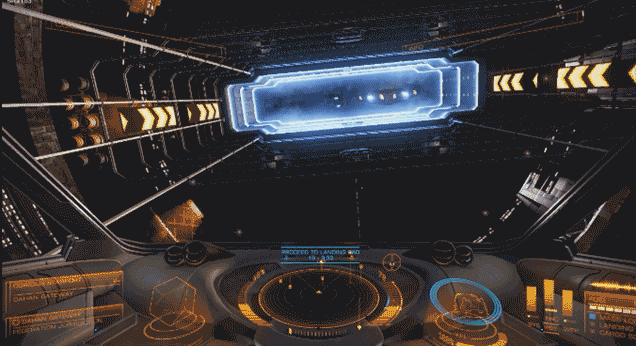
For a certain type of nerd who grew up watching a certain type of movie and playing a certain type of game, it does not currently get any better than this.
Of course, it will get better. There are a number of improvements that Oculus needs to make (and hopefully will make) before they launch the first commercial Rift. There are also a number of improvements Braben and his team at Frontier Developments need to make to Elite: Dangerous. And of course, there are a number of other VR-enabled space-sims looming, notably Star Citizen and EVE: Valkyrie, the latter of which has demoed so impressively on both the Oculus Rift and Sony’s Project Morpheus VR headset.
But while the people behind the scenes have their work cut out for them, the fact remains that for the past two weeks, I’ve been sitting at my desk playing an immersive virtual reality game like the ones we used to daydream about as kids. For all its rough edges, it’s been pretty much exactly as cool as I always thought it’d be.
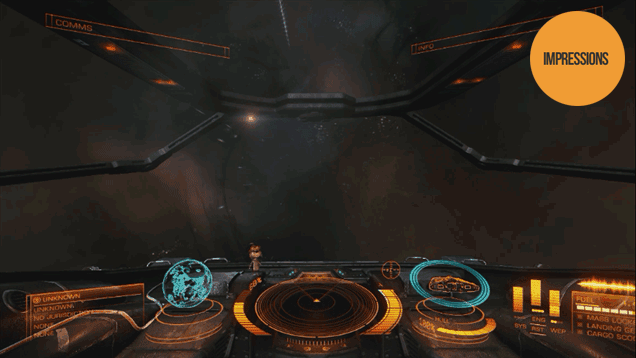
Comments
18 responses to “I Just Spent Two Weeks Being A Space Commander”
I really want to play this with the OR DK2
Been playing this with the DK2, it is amazing. Ignoring what I’m ‘supposed’ to be doing, I spend most of my time flying around marveling at the environment and trying to ‘touch’ items in the cockpit.
I just imagined a human trying to catch the red dot. Like a cat.
I’ve been doing the same, on the DK2, and my experience is similar.
I was really hoping they would have fixed the small text issue by now, and the Space Combat(TM) is for the most part too slow and pretty boring compared to, say, Star Citizen which gets it just right.
This is the sort of game that VR is made for, I keep banging on, but I think VR will find a niche in space exploration/combat, flight sims/combat and driving games, but am still completely unconviced that it will become more than a novelty anwhere else.
Part of the problem is this:
Now people keep saying, but yeah what about when it becomes the size of a pair of glasses etc. but it quite simply will not. The thing that makes it work, and really feel like you are there, is immersion, and that means a really wide Field Of View, and blocking out all other input, and good headphones (the sound needs to travel with you when you turn your head). You just won’t get that FOV and immersion in something that doesn’t wrap all the way around your vision, and block out all light.
Sure it will get lighter, and have higher resolution (eventually… rendering 4K per eye is going to take some time to come to fruition, and anything less is just not enjoyable once you get over the initial novelty), but it will still be (and should be) immersive, which means you still have the same problems as quoted above by Mark.
Having said all that, I am really looking forward to some great Space games coming out and playing them in VR, I just hope that some other titles come up soon that work better as a VR experience.
I’d like to see it become a complete helmet. Like a motorbike helmet. Built in speakers, easy to put on and take off. Block out external sound / light and perhaps make the visor liftable to easy conversation or breaks or finding where you dropped something.
I want to go to there.
Just got my DK2 yesterday and had a play last night…got a fair ways in getting it setup properly. Keen to give some games like this a go (I have pre-ordered Star Citizen) however just can’t seem to get the FOV right…which kind of ruins the immersion IMO (feels like I am looking into a box). I’m sure some mucking around with it over the next few days will change that.
The FOV is just too narrow on the DK2, you can adjust it a bit, but yeah, it is a bit like looking through a bucket.
BTW, I bought Elite Dangerous, but what package did you go for on Star Citizen? I’ve played it a lot at a mate’s house, in exchange for him hanging onto my old DK1, but I find the packages confusing, don’t want to shell out and find there is some other part I have to pay more for to get going in the game.
well it all depends on what you plan on doing in the final game but to be honest the Aurora is a pretty solid ship(the cheapest one) and for 45 bucks for that and the alpha access its a pretty good deal.
I pre-ordered it a while ago…haven’t actually got around to installing the arena commander or anything yet…it is a bit confusing the packages…i got the $100 one i believe that includes some ships, full game etc
Hey, We must have been Batch Buddies, got mine too. (paid Thursday, got it Monday… crazy)
When I set my IPD I basically made sure the green bars in the configuration were essentially gone and only that little white pointer was just edging on a green spec. I may have done that wrong for the moment but it did seem to add a little, at least to my eyes. Then I made sure to set the eye cup distance on the config app to the same notch as the one I set on the HMD. Futz with that a little too and it may feel less like wearing swimming goggles.
For the moment the FOV is a little annoying but I have found that it’s tolerable. I think if you had a DK1 you will absolutely notice more though but considering we know we are at least getting 110 for the CV1 and higher resolution I can’t be too down on this step.
Thanks for the tip…i’ll play around with the IPD etc again tonight. I have the “B” Lens’ in also as i’m short sighted…i think i might try putting in the A lenses again and use my glasses to see if that makes a difference.
It’s articles like this that make me want to go out and throw my money at a DK2….but the logic in me tells me to wait until the consumer model is released 🙁
Does anyone know of a place in Sydney where I can try the DK2?
I’m a lowly DK1 user, but for me it’s basically plug-and-play. Zero issues at all, and it’s pretty fantastic. The small text isn’t all that much of an issue, I can still mostly read the things being said. Though I’d still like to be able to tap into the positional tracking by strapping on a Hydra controller, that’d be nice.
Clocked 60 hours since the beta opened on the 29th, but had a whole load more pumped into it with the single player preview when they opened that up a week or two beforehand. And it’s only going to get better from here.
I fear for my life.
I have a DK1 and am chomping at the bit to play this but was worried about the cockpit text and visibility when targeting. Is it really that playable on the DK1?
I have VoiceAttack as well which will make some controls a bit easier I think if you can set macros for things like landing gear.
Well I spent some time playing the game without the DK1, so got to know what most of the screen elements said well enough to recognise them. Once you’re in there it just kind of takes the right combination of head and eye movement to make any unclear words appear clear enough, but for the most part I don’t think the words are overly important. Not at this stage at least.
I’ve heard a lot of talk about Voice Attack, but I’m not a fan of speaking so haven’t looked into it. I’m still yet to play with the Rift and my joystick, but I was playing it just fine on controller without it. You can do mutli-button binds, so using Select/Back/whatever you want to call it as a kind of shift key essentially doubled the number of buttons I had on hand, and let me move the less important ones like cargo scoop and landing gear out of the way.
Cheers for the response – seeing as DK2 orders aren’t being filled until October now I may just purchase the beta now. This is going to be an epic timesink…
if you’re playing Elite, Star Citizen or just using an Oculus Rift for gaming, you’ll probably find VoiceAttack to allow you to give voice commands. When you do, you’ll want a real human voice to talk back when you give your computer a command.
http://vrcompilations.com/
Vocal Response Compilations. A huge pack of custom recorded phrases so your computer has teh reponse you want when you’re flying your fancy Star Citizen purchase or chewing up the lightyears in your Cobra MkIII.
I was luckly enough to get a few hours on the Rift and Elite: Dangerous at FantasiCon last week (where the books that accompany the game where launched [https://www.fantasticbookspublishing.com/store/]). It is a great deal of fun, and while may initial reaction was I need to get a DK2, after play for a bit longer I saw that I really need to wait for the commercial version when it is release.
However, I do think saying that Elite: Dangerous has trading straight out of EVE Online and combat out of Star Wars is misleading. David Braben and Ian Bell released the first incarnation of Elite back on the 30th September 1984 – that’s almost 30 years ago. We talking 8-bit platform games era. Elite was the first game to give us a 3D gaming area. It is the great-granddaddy of 3D gaming – every other 3D game since then owes something to that original.